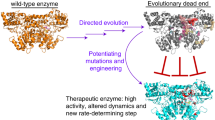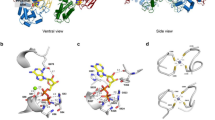Abstract
Tunicamycins are nucleoside natural products and show antibacterial, antiviral and antitumor activities, which are attributed to their inhibition of enzymatic reactions between polyisoprenyl phosphate and UDP-GlcNAc or UDP-MurNAc-pentapeptide. Because of their various intriguing biological activities, tunicamycins have potential as therapeutic agents for infectious diseases or cancers. Structurally, tunicamycins have a unique structure composed of an undecodialdose skeleton, a lipid chain and a GlcNAc fragment linked by a 1,1-β,α-trehalose-type glycosidic bond. In this mini review, we summarize the total chemical syntheses and biosynthetic studies of tunicamycins.
Similar content being viewed by others
Log in or create a free account to read this content
Gain free access to this article, as well as selected content from this journal and more on nature.com
or
References
Takatsuki A, Arima K, Tamura G. Tunicamycin, a new antibiotic. I. J Antibiot. 1971;24:215–23.
Takatsuki A, Tamura G. Tunicamycin, a new antibiotic. II. J Antibiot. 1971;24:224–31.
Takatsuki A, Tamura G. Tunicamycin, a new antibiotic. III. J Antibiot. 1971;24:232–8.
Takatsuki A, Tamura G. Effect of tunicamycin on the synthesis of macromolecules in cultures of chick embryo fibroblasts infected with new castle disease virus. J Antibiot. 1971;24:785–95.
Ito T, et al. The structure of tunicaminyl uracil, a degradation product of tunicamycin. Agric Biol Chem. 1977;41:2303–5.
Takatsuki A, et al. The structure of tunicamycin. Agric Biol Chem. 1977;41:2307–9.
Ito T, Takatsuki A, Kawamura K, Sato K, Tamura G. Isolation and structures of components of tunicamycin. Agric Biol Chem. 1980;44:695–8.
Anderson JS, Matsuhashi M, Haskin MA, Strominger JL. Lipid-phosphoacetylmuramyl-pentapeptide and lipid-phosphodisaccharide-pentapeptide: presumed membrane transport intermediates in cell wall synthesis. Proc Natl Acad Sci USA. 1965;53:881–9.
Struve WG, Neuhaus FC. Evidence for an initial acceptor of UDP-NAc-muramyl-pentapeptide in the synthesis of bacterial mucopeptide. Biochem Biophys Res Commun. 1965;18:6–12.
Lehrman MA. A family of UDP-GlcNAc/MurNAc: polyisoprenol-P GlcNAc/MurNAc-1-P transferases. Glycobiology. 1994;4:768–71.
BrandishP. E, et al. Modes of action of tunicamycin, liposidomycin B, and mureidomycin A: inhibition of phosphor-N-acetylmuramyl-pentapeptide translocase from Escherichia coli. Antimicrob Agents Chemother. 1996;40:1640–4.
Boyle DS, Donachie WD. mraY is an essential gene for cell growth in Escherichia coli. J Bactetiol. 1998;180:6429–32.
Schmidt G, Myer H, Mäkelä PH. Presence of rfe genes in Escherichia coli: their participation in biosynthesis of O antigen and enterobacterial common antigen. J Bacteriol. 1976;127:755–62.
Anderson MS, Eveland SS, Price NPJ. Conserved cytoplasmic motifs that distinguish sub-groups of the polyprenol phosphate:N-acetylhexosamine-1-phosphate transferase family. FEMS Microbiol Lett. 2000;191:169–75.
Lehrer J, Vigeant KA, Tatar LD, Valvano MA. Functional characterization and membrane topology of Escherichia coli WecA, a sugar-phosphate transferase initiating the biosynthesis of enterobacterial common antigen and O-antigen lipopolysaccharide. J Bacteriol. 2007;189:2618–28.
Dabbagh BA, Lecreulx DM, Bouhss A. Purification and characterization of the bacterial UDP-GlcNAc:undecaprenyl-phosphate GlcNAc-1-phosphate transferase WecA. J Bacteriol. 2008;190:7141–6.
Kimura K, Bugg TDH. Recent advances in antimicrobial nucleoside antibiotics targeting cell wall biosynthesis. Nat Prod Rep. 2003;20:252–73.
Bugg TDH, Lloyd AJ, Roger DI. Phospho-MurNAc-pentapeptide translocase (MraY) as a target for antibacterial agents and antibacterial proteins. Infect Dis Drug Targets. 2006;6:85–106.
Winn M, Goss RJM, Kimura K, Bugg TDH. Antimicrobial nucleoside antibiotics targeting cell wall assembly: recent advances in structure-function studies and nucleoside biosynthesis. Nat Prod Rep. 2010;27:279–304.
Lehrman MA. Biosynthesis of N-acetylglucosamine-P-P-dolichol, the committed step of asparagine-linked oligosaccharide assembly. Glycobiology. 1991;1:553–62.
Thrum H, et al. Streptovirundins, new antibiotics with antibacterial and antiviral activity. I. Culture taxonomy, fermentation and production of streptovirudin complex. J Antibiot. 1975;28:514–21.
Vogel P, et al. Isolation of a group of glycolipid toxins from seedheads of annual ryegrass (Lolium rigidum Gaud.) infected by Corynebacterium rathayi. Aust J Exp Biol Med Sci. 1981;59:455–67.
Kenig M, Reading C. Holomycin and an antibiotic (MM 19290) related to tunicamycin, metabolites of Streptomyces clavuligerus. J Antibiot. 1979;32:549–54.
Nakamura S, Arai M, Karasawa K, Yonehara H. An antibiotic, mycospocidin. J Antibiot. 1957;10:248–53.
Mizuno M, Shimojima Y, Sugawara T, Takeda I. An antibiotic 24010. J Antibiot. 1971;24:896–9.
Price NPJ, et al. Quinovosamycins: new tunicamycin-type antibiotics in which the α,β-1′′,11′-linked N-acetylglucosamine residue is replaced by N-acetylquinovosamine. J Antibiot. 2016;69:637–46.
Suami T, Sasai H, Matsuno K. Synthesis of methyl hexaacetyl-tunicaminyl uracil. Chem Lett. 1983;12:819–22.
Suami T, et al. Synthetic approach toward antibiotic tunicamycins–VI Total synthesis of tunicamycins. Tetrahedron Lett. 1984;25:4533–6.
Suami T, Sasai H, Matsuno K, Suzuki N. Total synthesis of tunicamycin. Carbohydr Res. 1985;143:85–96.
Myers AG, Gin DY, Rogers DH. Synthetic studies of the tunicamycin antibiotics. Preparation of (+)-tunicaminyluracil, (+)-tunicamycin-V, and 5′-epi-tunicamycin-V. J Am Chem Soc. 1994;116:4697–718.
Li J, Yu B. A modular approach to the total synthesis of tunicamycins. Angew Chem Int Ed. 2015;54:6618–21.
Yamamoto K, Yakushiji F, Matsumaru T, Ichikawa S. Total synthesis of tunicamycin V. Org Lett. 2018;20:256–9.
Danishefsky SJ, DeNinno SL, Chen SH, Boisvert L, Barbachyn M. Fully synthetic stereoselective routes to the differentially protected subunits of the tunicamycins. J Am Chem Soc. 1989;111:5810–8.
Ramza J, Zamojski A. New convenient synthesis of tunicamine. Tetrahedron. 1992;48:6123–34.
Karpiesiuk W, Banaszek A. Highly stereoselective synthesis of α,β-linked, nonreducing disaccharides related to tunicamycin. Carbohydr Res. 1994;261:243–53.
Karpiesiuk W, Banaszek A. Stereoselective syntheses of the O, N-protected subunits of the tunicamycins. Carbohydr Res. 1997;299:245–52.
Sarabia F, Martin-Ortiz L, López-Herrera FJ. Synthetic studies towards the tunicamycins and analogues based on diazo chemistry. Total synthesis of tunicaminyl uracil. Org Biomol Chem. 2003;1:3716–25.
Ichikawa S, Matsuda A. Synthesis of tunicaminyluracil derivatives. Nucleosides, Nucleotides Nucleic Acids. 2004;23:239–53.
Schmidt RR. New methods for the synthesis of glycosides and oligosaccharides – Are there alternatives to the Koenigs-Knorr method? Angew Chem Int Ed. 1986;25:212–35.
Zhu X, Schmidt RR. New principles for glycoside-bond formation. Angew. Chem. Int. Ed. 48, 1900–34 (2009).
Danishefsky SJ, DeNinno MP, Phillips GB, Zelle RE, Lartey PA. On the communication of chirality from furanose and pyranose rings to monosaccharide side chains: anomalous results in the glucose series. Tetrahedron. 1986;42:2809–19.
Chen X, Wiemer DF. α-Phosphono lactone analogues of cytidine and cytosine arabinoside diphosphates: synthesis via ring closing metathesis. J Org Chem. 2003;68:6597–604.
Tsvetanova BC, Kiemle DJ, Price NPJ. Biosynthesis of tunicamycin and metabolic origin of the 11-carbon dialdose sugar, tunicamine. J Biol Chem. 2002;277:35289–96.
Wyszynski FJ, Hesketh AR, Bibb MJ, Davis BG. Dissecting tunicamycin biosynthesis by genome mining: cloning and heterologous expression of a minimal gene cluster. Chem Sci. 2010;1:581–9.
Wyszynski FJ, et al. Biosynthesis of the tunicamycin antibiotics proceeds via unique exo-glycal intermediates. Nat Chem. 2012;4:539–46.
Widdick D, et al. Analysis of the tunicamycin biosynthetic gene cluster of Streptomyces chartreusis reveals new insights into tunicamycin production and immunity. Antimicrob Agents Chemother. 2018;62:e00130–18.
Hakulinen JK, et al. MraY-antibiotic complex reveals details of tunicamycin mode of action. Nat Chem Biol. 2017;13:265–7.
Yoo J, et al. GlcNAc-1-P-transferase-tunicamycin complex structure reveals basis for inhibition of N-glycosylation. Nat Struct Mol Biol. 2018;25:217–24.
Dong YY, et al. Structures of DPAGT1 explain glycosylation disease mechanisms and advance TB antibiotic design. Cell. 2018;175:1045–58.
Acknowledgements
This research was supported in part by JSPS Grant-in-Aid for Scientific Research (B) (Grant Number 16H05097 to S.I.), Grant-in Aid for Scientific Research on Innovative Areas “Frontier Research on Chemical Communications” (No. 18H04599 to S.I.), Takeda foundation, Astellas Foundation for Research on Metabolic Disorders, The Tokyo Biomedical Research Foundation and was partly supported by Hokkaido University, Global Facility Center (GFC), Pharma Science Open Unit (PSOU), funded by MEXT under “Support Program for Implementation of New Equipment Sharing System”, the Platform Project for Supporting Drug Discovery and Life Science Research (Basis for Supporting Innovative Drug Discovery and Life Science Research; BINDS) from the Japan Agency for Medical Research and Development (AMED).
Author information
Authors and Affiliations
Corresponding author
Ethics declarations
Conflict of interest
The authors declare that they have no conflict of interest.
Additional information
Publisher’s note: Springer Nature remains neutral with regard to jurisdictional claims in published maps and institutional affiliations.
This manuscript is dedicated to Dr Kiyoshi Isono’s 88 years’ anniversary and his long-standing contribution to the study of antibiotics, especially nucleoside antibiotics, polyoxins.
Rights and permissions
About this article
Cite this article
Yamamoto, K., Ichikawa, S. Tunicamycin: chemical synthesis and biosynthesis. J Antibiot 72, 924–933 (2019). https://doi.org/10.1038/s41429-019-0200-1
Received:
Revised:
Accepted:
Published:
Issue date:
DOI: https://doi.org/10.1038/s41429-019-0200-1
This article is cited by
-
Capturing time-dependent activation of genes and stress-response pathways using transcriptomics in iPSC-derived renal proximal tubule cells
Cell Biology and Toxicology (2023)
-
Involvement of Sec71 and Ubp2 in tunicamycin-induced ER stress response in the fission yeast
Molecular Biology Reports (2022)
-
CCAAT/Enhancer-Binding Protein Homologous Protein (CHOP) Deficiency Attenuates Heatstroke-Induced Intestinal Injury
Inflammation (2022)
-
ALG3 contributes to stemness and radioresistance through regulating glycosylation of TGF-β receptor II in breast cancer
Journal of Experimental & Clinical Cancer Research (2021)
-
Liposidomycin, the first reported nucleoside antibiotic inhibitor of peptidoglycan biosynthesis translocase I: The discovery of liposidomycin and related compounds with a perspective on their application to new antibiotics
The Journal of Antibiotics (2019)



